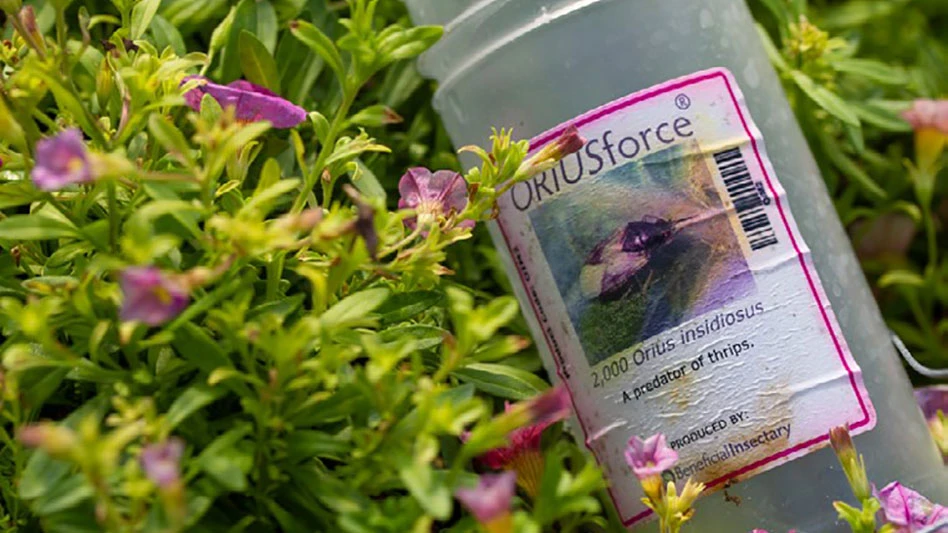

Sometimes it takes insects to fight insects. In those cases, growers can turn to using beneficial insects as biological control agents. Jake Taylor, head grower at North Carolina Farms in Indian Trail, North Carolina, uses beneficial insects as part of the overall pest control strategy. North Carolina Farms is a wholesale starter plant company that supplies rooted plugs and unrooted cuttings.
“Beneficials are a useful tool for integrated pest management, or IPM,” Taylor says. “Beneficial insects are an excellent resource for growers who want to use fewer pesticides on their crops while ensuring limited pest populations.”
Strength in numbers
At North Carolina Farms, Taylor uses several different kinds of beneficials to ward off different pests. “Currently, we are using a mixture of aphid predators (Aphidius colemani and Aphidius ervi), moth egg parasitoids (Trichogramma brassicae), spider mite predators (Phytoseiulus persimilis), a generalist predator (Orius insidiosus), whitefly parasites (Encarsia formosa) and soil-dwelling beneficial nematodes (Steinernema feltiae).”
“We chose this array of beneficials to ensure we could maintain control of a variety of pests,” Taylor explains. “Rather than choosing one or two predators or parasitoids, it is key to include a multitude of beneficials in your IPM program to be effective.”
In 2020, Mick Donahue, co-owner of North Carolina Farms, included each of the aforementioned insects in his article, “Top ten beneficial insects for commercial greenhouse production” (bit.ly/top-beneficial-insects). Other beneficials from the list include Amblyseius swirskii and Amblyseius cucumeris, Stratiolaelaps scimitus, Dalotia coriaria and Neoseiulus californicus. “I stand by Mick’s list of top 10 beneficial insects,” Taylor says. “We use many of the beneficials he wrote on his list, and so far, they have stood the test of time.”

However, Taylor isn’t set in his ways and remains open to using other insects, adding, “We are always looking at introducing more or different beneficials into our program.”
Thanks to their usefulness at preventing harmful insects from taking a hold in the greenhouse, beneficials are becoming a more popular tool. As this trend persists, Taylor expects more growers to implement them. “I am a big fan of beneficial insects,” Taylor says. “I would encourage any grower new to using beneficials to try them out.”
There’s important information that growers have to know before using beneficial insects. Despite their effectiveness as a pest control tool, using beneficials still comes with some downsides and challenges to be aware of.
Know the limits
One downside of beneficials, according to Taylor, is that they aren’t all that effective against full-blown infestations. “Beneficials are great at keeping pest populations in check,” Taylor says. “They are not the best option to eradicate pest infestations because they work slower to kill or parasitize pests, unlike an insecticide spray that can kill hundreds to thousands of pests at once.”
This is why Taylor’s advice for growers considering using beneficials is, “You have to start using beneficials when you are clean. Don’t wait until you see an outbreak to bring them in. Plan ahead and start releasing early.”
But Taylor says this doesn’t mean that beneficials don’t have a place in a quality IPM strategy, as they are still great tools for preventing pest infestations before they even happen, and for controlling low pest populations before they get bigger and become a problem. It’s important to use both beneficials and insecticides when it comes to battling pests. And this is something Taylor himself had to learn when he joined North Carolina Farms in 2021.
“Since joining the team, I have learned how best to manage our IPM program by determining when to use insecticides and when to use beneficials.”
When it comes to other challenges of beneficials, Taylor says the main challenge is choosing which insects to use.
“Different beneficials control different kinds of pests,” he explains. “For example, Aphidius colemani and Aphidius ervi are solely aphid predators.”
“It is important to determine what pests you are targeting,” Taylor says. “Research the best predators that fit your needs, and you can always talk to your beneficial insect supplier, who will have lots of information to help you.”
Even after you determine the right pest to use, there comes an additional challenge: “determining what life stages of a pest a beneficial insect controls,” Taylor adds. “Some beneficials prefer larval stages or eggs, and some control adults. So, take time to talk to your beneficial insect supplier and research the type of beneficials you need to control the entire life cycle of a pest or pests you may face.”

Explore the January 2023 Issue
Check out more from this issue and find your next story to read.
Latest from Greenhouse Management
- California Spring Trials 2026 dates announced
- Les Evans promoted to DRAMMwater segment manager, Al Zylstra to retire
- Hoffmann Family of Companies to acquire N.G. Heimos Greenhouses
- GIE Media Horticulture Group wins five regional 2025 Azbee Awards of Excellence
- Grant awarded to test western U.S. wood species for use as wood fiber potting substrate
- Pennsylvania Horticultural Society announces 2025 Gold Medal Plant winners
- Oasis Grower Solutions announces new Southeast territory sales manager
- How to reduce labor in greenhouse vegetable production





